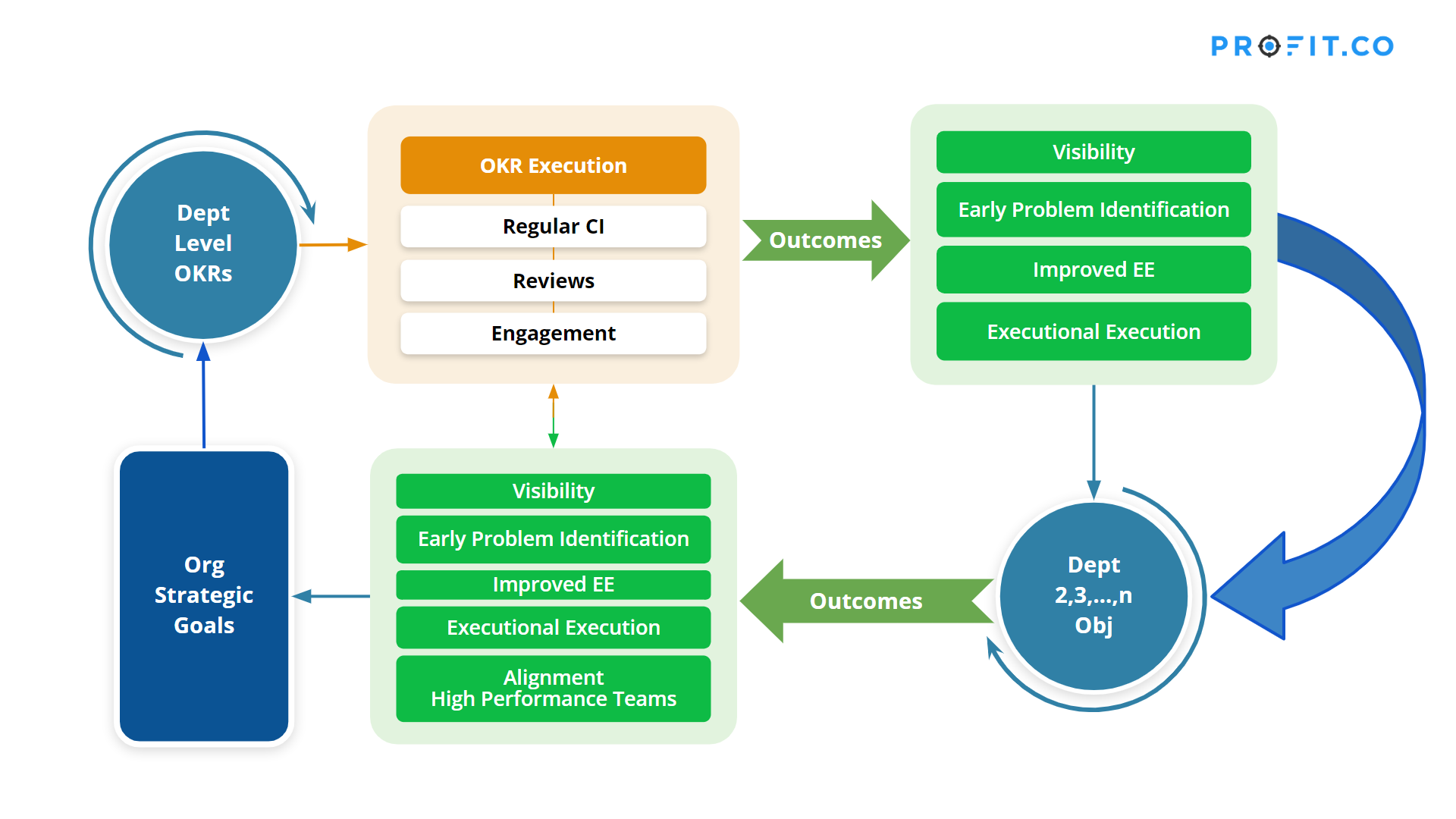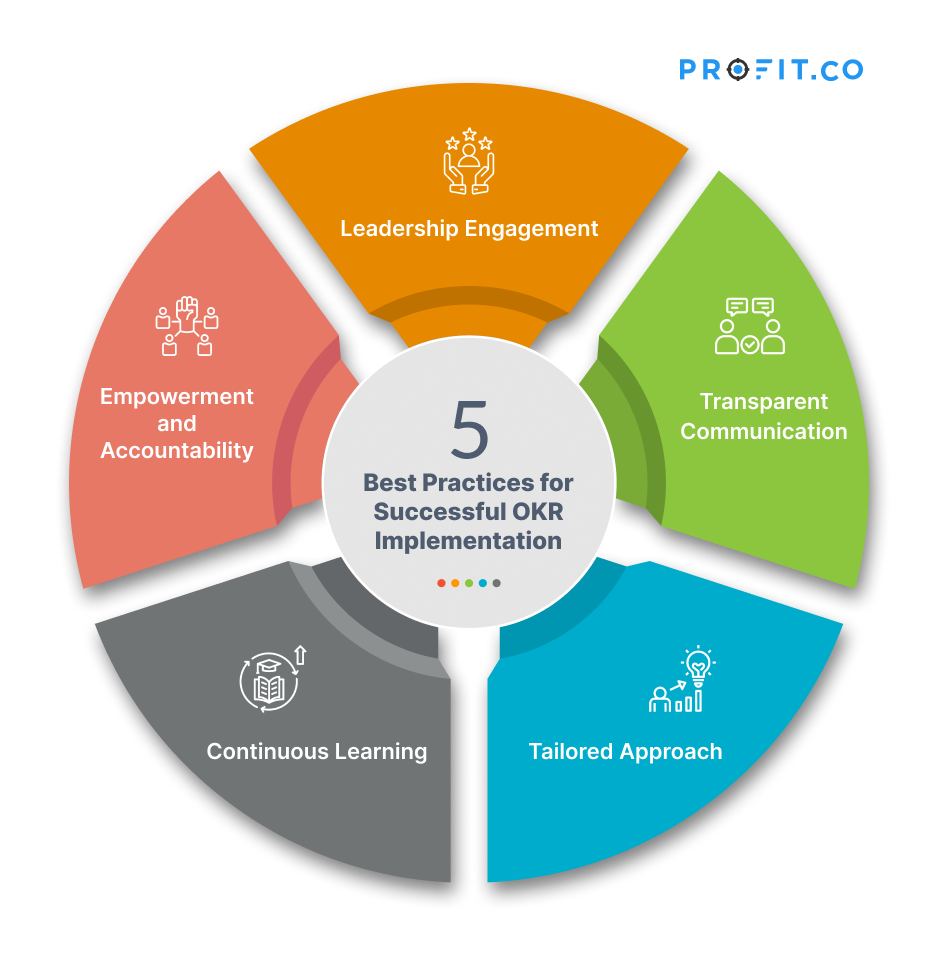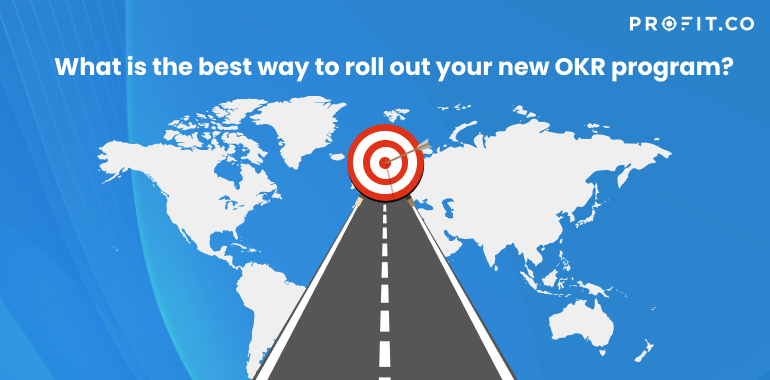In the evolving landscape of organizational transformation, the question of how to effectively implement strategic execution programs, such as an OKR (Objectives and Key Results) transformation via platforms like Profit.co, frequently arises. The dilemma often revolves around identifying the most efficient rollout approach and navigating the complexities of change management. Organizations typically consider two choices:
- Management level-by-level rollout
- Department-focused rollout

However, the crux of the matter extends beyond mere implementation strategies to a deeper, more fundamental objective – the pursuit of a significant cultural shift within the organization.
OKRs (and other StratEx approaches) Work. Period.
Adapting and personalizing strategic execution methodologies, such as OKRs (Objectives and Key Results), to fit the unique contours of your organization is a pragmatic and effective approach. This customization process not only enhances the methodology’s relevance to your specific operational context but also fosters a sense of ownership and commitment across the organization. By initiating this process in select departments, functions, or business units, you create a fertile ground for the organic emergence of best practices that are tailored to your organizational needs and challenges.

Skepticism about the efficacy of OKRs, or any strategic framework, often arises from a lack of understanding or improper implementation rather than an inherent flaw in the methodology itself. It’s crucial to recognize that strategic execution frameworks, including OKRs, STM (Strategy Tactics and Measures), WIGs (Wildly Important Goals), BHAGs (Big Hairy Audacious Goals), and the Balanced Scorecard, offer a diverse toolkit. Each comes with its strengths and weaknesses, but the unifying truth is their potential effectiveness when correctly applied. The success of these methodologies is not in question; what matters is the adaptation and execution strategy that aligns with your organizational culture and goals.
The evolution of a strategic framework within an organization should be a deliberate, adaptive process, rather than a sudden overhaul. By starting with a few key areas and gauging their receptivity and alignment with the chosen methodology, you can iteratively refine and expand its application. This phased rollout allows for real-time learning and adjustment, ensuring that the methodology resonates with and is effective for your organization. Within a few months to half a year, you’ll be able to assess its impact and suitability, paving the way for a broader organizational adoption.
This approach underscores the importance of cultural transformation as a core component of strategic execution. Early adopters play a crucial role in this process, serving as champions of the methodology from the executive level down to individual contributors. Their experiences, insights, and feedback become invaluable resources, offering practical guidance on addressing challenges and leveraging opportunities unique to your organization.
Moreover, the collective journey of adapting and adopting a strategic framework fosters a culture of continuous improvement, collaboration, and strategic agility. As your organization progresses, the shared experiences of navigating the implementation process will enrich your collective knowledge base, making it easier to tackle future challenges and seize new opportunities.
In essence, the successful implementation of a strategic execution framework like OKRs is less about rigid adherence to a prescribed set of practices and more about cultivating an adaptive, learning-oriented organizational culture. By embracing this evolutionary, iterative approach, your organization can not only achieve its strategic objectives more effectively but also foster a dynamic environment where innovation, engagement, and operational excellence thrive.
Ready to start your OKR journey today?
Level-by-Level Approach
The level-by-level strategy, which involves rolling out the OKR framework from top management down through the ranks, is a common initial consideration. This method starts with the upper echelons of the organization (Level 1 and Level 2) before progressing to the subsequent levels. While theoretically appealing for its structured approach, this method often encounters practical challenges. For instance, the varying depths of departmental hierarchies can complicate the process. Technology and engineering departments, with their typically extensive hierarchies, exemplify the potential difficulties in applying a uniform approach across different organizational units.

Anecdotal evidence suggests that the level-by-level approach may quickly escalate into a broader, company-wide initiative. The demand for inclusion from lower levels (e.g., Level 3) tends to surface sooner than anticipated, driven by the middle management’s need for comprehensive engagement across their teams.
Are you simply trying to collect & aggregate status or trying to change your culture?
The goal of implementing OKRs or similar frameworks is NOT merely to enhance status reporting or visibility but to foster a deeper, more transformative cultural shift within the organization.
Level-by-level rollout of strategic execution programs, such as OKRs generally equates to mere status aggregation without catalyzing true cultural change. Hence this approach might fall short of fostering a transformative organizational environment. It is very important to adopt OKRs not just as a methodological shift but as a catalyst for profound cultural evolution within an organization. The level-by-level approach, while seemingly orderly and structured, often misses the mark on initiating the deep cultural shifts necessary for the long-term success of strategic frameworks like OKRs.
The Shortcomings of Status Aggregation
In a level-by-level rollout, the introduction of OKRs starts at the top of the organizational hierarchy and progressively moves down to each subsequent level. This method tends to focus on the mechanical aspect of reporting objectives and key results upwards, transforming OKRs into a sophisticated form of status reporting. While this may enhance visibility into departmental and individual objectives, it inherently limits the potential for fostering a culture of collaboration, innovation, and empowerment across the organization.
Lack of Engagement and Ownership
One of the critical pitfalls of treating OKRs as mere status reports is the potential for diminished engagement and ownership among team members. When objectives and key results are perceived as tools for upward reporting rather than instruments for empowerment and alignment, employees may feel disconnected from the organization’s strategic vision. This disconnection stifles the motivation to innovate and take ownership of outcomes, essential elements of a high-performance culture.
Missed Opportunity for Cross-functional Collaboration
A level-by-level approach also misses the opportunity to promote cross-functional collaboration. True cultural transformation through OKRs involves breaking down silos and fostering an environment where teams across different departments work together towards common objectives. By merely aggregating status, organizations fail to leverage the collaborative potential of OKRs, limiting their ability to respond to challenges and opportunities in a cohesive manner.
Is there a scenario where the level by level approach might work?
We have not seen much success with level-by-level rollouts, if the organization does not have significant prior experience with the methodology. This approach will ONLY work, if your organization is already well adept with the OKR methodology and you are only rolling out a new software platform. And even here this is intended to be a quick pilot to ensure that the leadership team is happy with the new tool.
Department focused rollout
As mentioned before, believing that a phased, level-by-level rollout represents the optimal strategy for implementing OKRs underscores a limited perspective, particularly when considering the broader objective of achieving organizational culture change and transformation. Such deep-seated change cannot be effectively realized through incremental implementation alone; it requires a more holistic approach. However, recognizing the impracticality of instituting widespread change across an entire organization simultaneously, a strategic compromise approach exists – targeting select business units or functions for initial implementation.
Opting to introduce OKRs within a handful of departments—specifically, those of a manageable size that accurately reflect the broader organizational structure and culture—presents a viable strategy. This focused approach enables an organization to trial the methodology in a controlled, yet representative, environment. Through this pilot, valuable insights can be garnered regarding the efficacy of the OKRs, the challenges encountered, and the necessary adjustments to the framework. Such a process allows the methodology to be refined and tailored to the organization’s unique context, ensuring a more effective and meaningful implementation.
Iteratively develop your own best practices
Moreover, by selecting two to three departments or business units as the initial focus for OKR implementation, an organization can cultivate a microcosm of best practices and lessons learned. This concentrated effort not only facilitates a more nuanced understanding of how OKRs can be most effectively applied within the specific organizational context but also encourages the organic development of a tailored process that resonates more deeply with the company’s culture and operational needs.

In essence, this approach strikes a balance between the need for comprehensive cultural transformation and the practicalities of organizational change management. It acknowledges the limitations of a purely sequential rollout while leveraging the benefits of a targeted, pilot-based implementation strategy. By doing so, an organization can lay the groundwork for a more expansive and impactful adoption of OKRs, ultimately fostering an environment of continuous improvement, strategic alignment, and enhanced performance across the entire organization.
Cultural Transformation Through Inclusive Implementation
Contrasting with the level-by-level method, an inclusive approach to implementing OKRs—one that engages all levels of the organization simultaneously—can serve as a powerful driver of cultural change. This strategy acknowledges that for OKRs to be truly effective, they must permeate the organization’s fabric, influencing not just how goals are set and measured but also how individuals and teams interact, collaborate, and innovate.
Fostering a Culture of Transparency and Accountability
An inclusive OKR implementation cultivates a culture of transparency and accountability. By involving every layer of the organization from the outset, OKRs become a shared language for discussing progress, challenges, and achievements. This openness encourages a shift away from hierarchical gatekeeping of information to a more democratized, trust-based culture where everyone feels responsible for the organization’s success.
Empowering Teams and Encouraging Innovation
Moreover, when OKRs are embraced organization-wide, teams are empowered to set ambitious goals, experiment with new ideas, and learn from failures. This empowerment is crucial for driving innovation and adaptability, enabling organizations to navigate the complexities of today’s business landscape more effectively.
Critical success factors of an OKR implementation
The journey towards effective implementation of strategic execution programs like OKRs is both challenging and rewarding. By understanding the nuances of different rollout strategies, recognizing the imperative for cultural transformation, and drawing on real-life examples and best practices, organizations can navigate this journey more effectively. The ultimate goal is not just the adoption of a new framework but the realization of a cultural shift towards greater agility, transparency, and performance. Through careful planning, committed leadership, and continuous adaptation, organizations can unlock the full potential of OKRs to drive strategic success and operational excellence.
Real-Life Examples of Cultural Transformation
Perhaps the most quintessential example is Google’s adoption of OKRs, which has been integral to its culture of innovation and continuous improvement.
Intel
As the birthplace of OKRs, Intel’s use of the framework under Andy Grove’s leadership exemplifies how strategic execution can drive operational excellence and market dominance. Intel’s disciplined approach to OKRs facilitated its turnaround and leadership in the semiconductor industry.
LinkedIn’s adoption of OKRs has been pivotal in aligning the organization’s efforts towards strategic goals while maintaining flexibility in a fast-changing industry. The platform’s focus on leveraging OKRs to foster growth and innovation demonstrates the framework’s adaptability across different organizational contexts.
CELO
After CELO implemented OKRs successfully in select departments, the company demonstrated exceptional strategic prowess by extending the methodology across all facets of their organization. This proactive approach to goal-setting not only streamlined operations but also fostered a culture of accountability and collaboration company-wide. Their progressive adoption of OKRs reflects a commitment to continuous improvement and organizational excellence.
Best Practices for Successful OKR Implementation
Drawing on these examples, several best practices emerge for organizations looking to implement OKRs or similar strategic execution frameworks:

Leadership Engagement
Successful implementation begins with strong leadership commitment. Leaders must not only endorse the OKR framework but also actively participate in setting and reviewing OKRs.
Transparent Communication
Building a culture of transparency around goals, progress, and challenges is essential. This openness encourages collaboration and helps align efforts across the organization.
Tailored Approach
Recognizing the unique aspects of different departments and adapting the OKR framework to meet these nuances can enhance its effectiveness and acceptance.
Continuous Learning
Implementing OKRs is an iterative process. Organizations should foster a culture of feedback and continuous improvement, learning from both successes and setbacks.
Empowerment and Accountability
Empowering employees to set their own OKRs within the context of the organization’s strategic goals fosters engagement and accountability.
Conclusion
The journey towards effective implementation of strategic execution programs like OKRs is both challenging and rewarding. By understanding the nuances of different rollout strategies, recognizing the imperative for cultural transformation, and drawing on real-life examples and best practices, organizations can navigate this journey more effectively. The ultimate goal is not just the adoption of a new framework but the realization of a cultural shift towards greater agility, transparency, and performance. Through careful planning, committed leadership, and continuous adaptation, organizations can unlock the full potential of OKRs to drive strategic success and operational excellence.
Ready to start your OKR Journey for FREE?
Related Articles
-
Profit.co is FedRAMP Ready. Trusted Execution for Federal Agencies Just Got Simpler
In a world where data security, compliance, and mission success are non-negotiable, Profit.co stands out as a trusted partner for... Read more
-
Tim Newbold: Drive OKR Outcomes with Confidence Scoring
You're not alone if you're unsure how confident your team is about achieving its OKRs this quarter. Many teams operate... Read more
-
Tim Newbold on Leading Outcome-Obsessed Teams with OKRs
In many team meetings, a recurring pattern emerges Team members provide updates such as, “I completed tickets 247 and 248,”... Read more
-
How Top Teams Win with Weekly OKR Check-Ins – Insights from Tim Newbold
Set a goal. Cross your fingers. Hope for the best.Sounds familiar?That’s how too many teams treat OKRs. They set goals,... Read more

